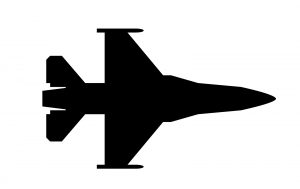
ACCEL-RF EMPOWERS YOU TO DELIVER RELIABILITY WHEN IT MATTERS MOST
Reliability in electronic components is a necessity that stretches throughout all sectors of business and government. Harsh environments, remote locations, and incredibly high stakes, however, add up to make the aerospace and defense industries especially demanding to achieve electronic component reliability. No room for guessing exists for predictions about device performance degradation when so much is riding on the data.

Accel-RF’s line of accelerated life testing platforms has been the choice of aerospace and defense companies and agencies for over 15 years for gaining confidence in the reliability of RF semiconductor components. These instruments provide an economical way to meet the unique challenges associated with the stringent reliability requirements of this market. Accel-RF’s integrated solutions give aerospace and defense organizations a proven method to collect data, predict device lifetimes, and show compliance required for mission-critical performance.
WHAT AEROSPACE AND DEFENSE STAKEHOLDERS NEED MOST
Manufacturers build avionic and military components by drawing on the same semiconductor supply chain used by manufacturers of consumer electronics. The difference in sourcing components in this application lies in the need for proven reliability for the aerospace and defense equipment users. An off-the-shelf chip with performance data geared toward a commercial market is usually insufficient for the aerospace and defense market. Semiconductors used in aerospace and defense applications must meet rigorous reliability standards. Applications such as a satellite orbiting above the earth or a radar system protecting strategic air space, are critical operational systems that must have known reliable components.
To get approval for designs and win contracts, manufacturers must ensure that their equipment functions throughout the predetermined lifecycle of the project. They require a way to quickly acquire and easily share measured reliability metrics for critical components in the system.
They also must measure the performance degradation of devices when used in the intended application. Continual data reporting on device failures provide vital direction on any required design or process refinements that may be needed. In a competitive market where success depends on a perfect marriage of speed to market and demonstrated performance, getting this information early in production is critical.
IMPORTANT RELIABILITY PARAMETERS OF CONCERN
DC Bias Current
Active semiconductor components require a DC power supply to operate. The DC bias voltage and current levels are critical parameters as the power dissipation of each active element will contribute to temperature rise and drive overall efficiency.
Industries:
![]()
![]()
![]()
![]()
![]()
![]()
![]()
![]()
RF Output Power
The RF output power of an amplifier drives the overall capabilities of a transmitter. The saturation level and how the output power of a device compresses with input power is used to determine which applications and systems are suitable for that device.
Industries:
![]()
![]()
![]()
![]()
![]()
![]()
![]()
RF Gain
The ratio of RF power delivered to a load relative to the input power. How gain changes and compresses as these levels rise and approach saturation is critical to designing systems for any RF application.
Industries:
![]()
![]()
![]()
![]()
![]()
Ohmic Contact Resistance
In semiconductors, this is the intrinsic resistance through the metalized terminals of the device into the channel or junction. A physical change in the ohmic contacts, which can be an effect of metal migration, can change the resistance and impact the electrical performance of a device.
Industries:
![]()
![]()
Intermodulation Distortion
IMD occurs when two signals are present in a nonlinear system, such as an amplifier. The frequency harmonics of these two signals mix and create 2nd and 3rd order intermodulation products. Measuring and mitigating these distortion levels are critical for communication applications.
Industries:
![]()
![]()
![]()
![]()
Phase Noise
Commonly referred to as “jitter”, phase noise is the random fluctuations of the phase of a signal source. It is present in oscillators and digital clocks and can have detrimental effects on a system where frequency conversion takes place. A signal with high phase noise can end up occupying more of the spectrum than intended and introduce error.
Industries:
![]()
![]()
![]()
![]()
Noise Figure
This is a critical parameter in all Receiver designs. The Noise Figure must be low for a system to be sensitive enough to detect and process weak signals. Low Noise Amplifiers (LNA) are typically the first element in a receiver and are designed to minimize Noise Figure.
Industries:
![]()
![]()
![]()
![]()
![]()
Signal Linearity
For amplifiers in RF applications, this represents the relationship between the input power and the output power of a device. At low input power levels, linearity is uniformly quantified by the gain. As input drive increases, the device gain compresses as the device saturates and the linearity characteristics change.
Industries:
![]()
![]()
![]()
![]()
![]()
Switching Response Time
The rise and fall time of RF switches used in high-frequency applications can set limitations on the bandwidth and other key aspects of a system. When used in a phased array, the switching speed can limit how quickly the beam can be steered, for example.
Industries:
![]()
![]()
![]()
![]()
Frequency Stability
This represents the ability of a source, such as an oscillator, to maintain a constant frequency output. Outside influences such as temperature and change in bias voltage can lead to drift and affect frequency stability. Stability in communication systems is required so that a signal does not drift outside of its designated band.
Industries:
![]()
![]()
![]()
![]()
![]()
![]()
The use of RF systems in Aerospace and Defense platforms is likely the largest market application of RF semiconductors. Radar, Navigation, Electronic Counter Measures, Electronic Counter-Countermeasures, Communications, and various sensors play an ever-increasing role in our military and aerospace equipment. Reliable electronics are the enablers for the market. Reliability testing is driven in this market by the following:
- Critical mission requirements and the essential need for operational success.
- Typical mission success relies on high technical performance achievements.
- Mission durations are usually “long-use” expectations.
- Maintenance cost (down-time) leads to inefficient system utilization.
- System performance consistency from unit to unit for effective deployment.
- Performance degradation with age would drive maintenance service costs.
SPACE AND SATELLITE APPLICATIONS
Environmental extremes and remoteness associated with space applications impose additional considerations concerning device reliability. Satellite launchers expect equipment to hold up under the wide temperature swings and more intense electromagnetic properties outside of the earth’s atmosphere. Added to the harsher conditions imposed on the device, is the difficulty of reaching them for repair and servicing.
When repair is not an option, no margin for error exists. Projects deployed in space often have lifecycles measured in decades instead of years or months. Satellite device components must not only meet statistically projected lifetime requirements but also go through burn-in to weed out any substandard parts. Accel-RF’s multifunction test systems can accomplish both tasks for achieving as close as possible to 100-percent quality assurance screening in a fast and effective manner.
MILITARY COMMUNICATIONS
The reliable flow of secure information determines the strategic advantage in any command-and-control situation. For this reason, military transmissions typically rely on narrowly fixed-band frequencies driven at high power levels. Finding a means to efficiently test military communication units over a wide range of frequencies, with sufficient output power characterization with age, can be a difficult task.
Accel-RF designs test platforms with frequency source units that contiguously cover large portions of the RF spectrum. The platform provides the required DC power sources to drive devices to RF power levels, for both RF inputs and outputs, to measure small-signal to saturation output power performance. This capability allows for easy acquisition of meaningful data on application-specific key performance indicators of the device or component. With this system-level performance data, the network engineering can be confidently assessed, and safety margin built in to keep the network operational under the various environments envisioned in the field.

ELECTRONIC WARFARE
Obtaining advantages on the modern battlefield requires complete knowledge and control of the electromagnetic spectrum. Electronic Warfare (EW) uses directed beams of RF energy to jam or disable the enemy’s tracking and communications equipment. Devices must have the capability to operate at all possible frequencies that may be present in order to gain complete coverage of the opportunities and address the threats inherent in the battlefield arena.
Testing with Accel-RF’s platform solutions enables the gathering of data on key performance indicators for devices and components intended for use at specific operational frequencies and power levels encountered in the EW environment. The ability to establish the reliability of components at varying frequency bands of interest (X-Band, Ku-Band, etc.) works to create the confidence needed to win approval for contracts related to these types of high-value military applications.
TESTING TECHNIQUES TO MEASURE RELIABILITY
Assessing quality assurance with the level of accuracy and statistically meaningful data sizes required by aerospace and defense contracts requires tracking data across multiple wafer lots. By using Accel-RF’s turnkey systems to collect data on multiple batches, contractors build a verifiable record of a repeatable and reliable manufacturing process used in their foundry. This allows the manufacturer to demonstrate statistical process control and, subsequently, the consistency of their fabrication procedure. Consistent performance may be used to drive change and improvement in the process. This, in turn, drives quality and reliability improvements.
The test results accumulated from Accel-RF’s instrument platforms quickly allows the manufacturer to quantify changes from adjustments made to process steps in the fabrication production line. For instance, if the plant implements a different metallization scheme or a variation to its passivation process, a new round of testing on the Accel-RF platform provides data on how the change affected device reliability and more importantly device RF performance. Information on intrinsic reliability and comparison of the degradation of key performance indicators to intended application parameters enables device manufacturers to assess the effect of their process or raw material changes on the finalized product early in the manufacturing route. Any detrimental performance detected may allow for a stop in workflow or scrap before further cost and time are wasted.
Testing with Accel-RF equipment can also help contractors find the root causes of component malfunctions. Manufacturers can submit devices to test regimes designed to accelerate degradation in a known device parameter, such as DC and/or RF. At a predefined level of degradation, the device testing may be automatically stopped. At this point, the degradation has reached a severe level of change, but catastrophic failure was averted. Sending these degraded chips for analysis with an electron microscope or similar failure analysis tool can help determine if a process problem, material selection, or a combination of both issues, caused the degradation and eventual failure.
RISE TO MEET RELIABILITY CHALLENGES IN AEROSPACE AND DEFENSE WITH ACCEL-RF’S PROVEN PLATFORMS
When selecting components for use in aerospace and defense applications, reliability is one of the most crucial considerations in choosing a manufacturer. The multi-dimensional test equipment available from Accel-RF provides the ability to thoroughly assess reliability concerns and performance degradation expectancy of today’s RF semiconductor components. Manufacturers gain the added ability to gather and share data among cross-functional groups for complete statistical analysis and decision-making assessments. With application-relevant data based on measured results, the manufacturer can present their products with confidence to industries that demand nothing less than the most reliable part available. The most reliable parts available come from manufacturers with high-reliability IQ levels. The “Field-Proven” platforms available from Accel-RF provide the tools for expanding reliability IQ.
Download The Defense Contractors Guide to Reliability Testing
Learn the ins and outs of reliability testing for government projects and why Accel-RF equipment has become the preferred test partner for defense agencies and other federal contracts.
